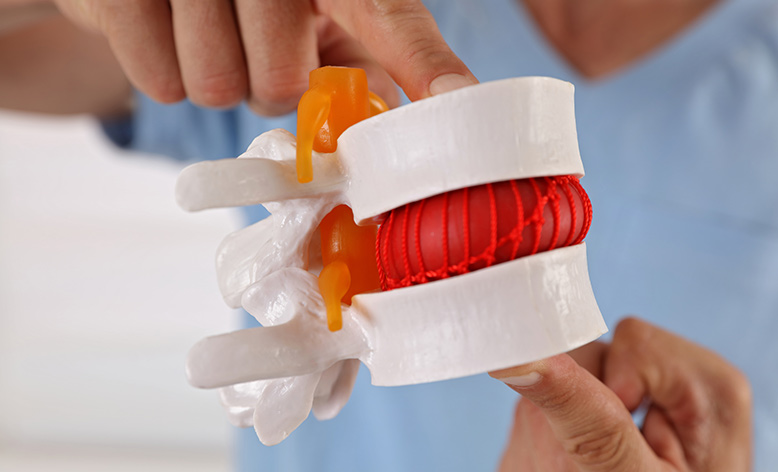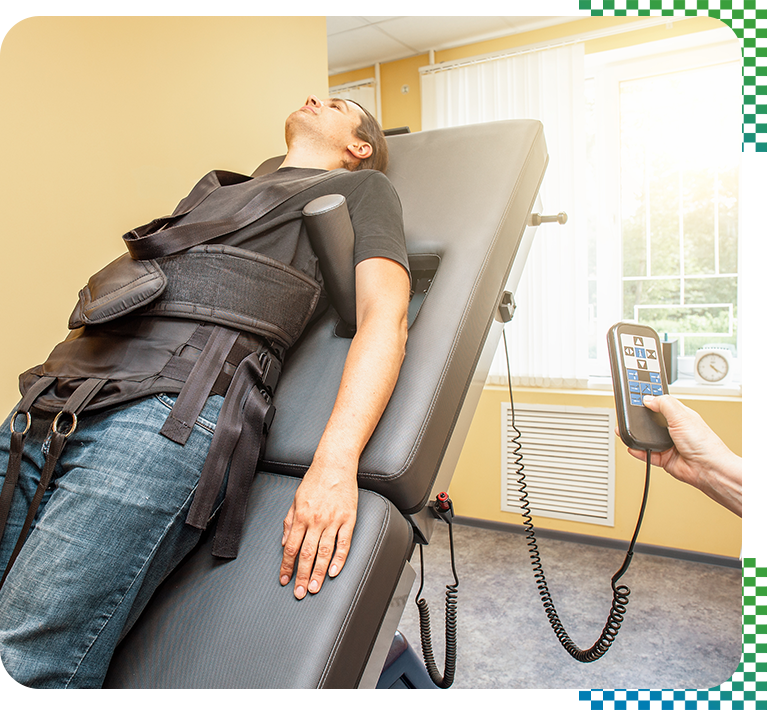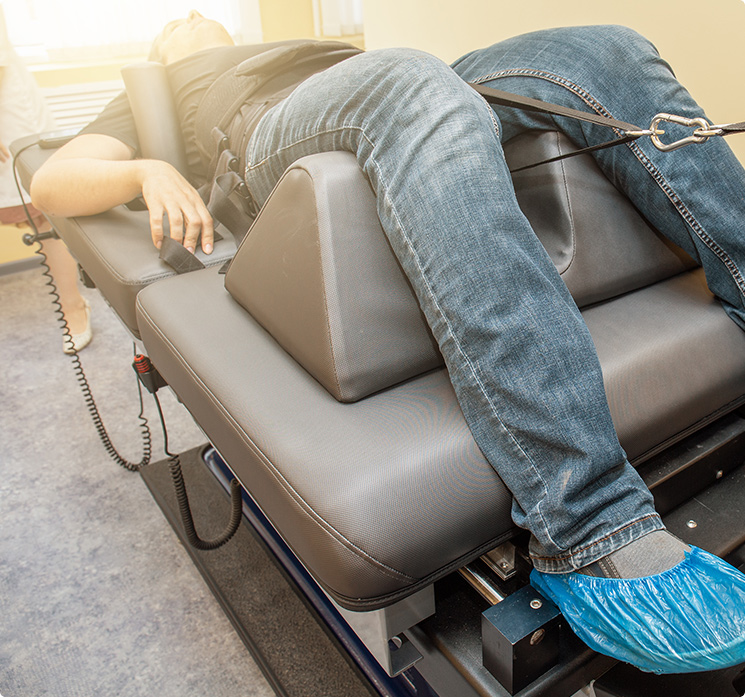Could you imagine going through life every day with near-debilitating, chronic back pain? Back pain is one of the most common ailments in America - it's estimated that 8% of all adults, or 16 million people, suffer from chronic back pain in the U.S. every year. If you've never experienced a back injury or pain, be thankful. Chronic back pain affects every aspect of a person's life, from participating in sports to limitations with everyday activities, like cooking dinner. In fact, many people with chronic back pain can't even make a reliable living and put food on the table. Almost 83 million workdays are lost every year due to choric back pain.

The inability to work and provide isn't just a physical issue - it can become an emotional one too. Many people suffering from chronic back pain also suffer from depression and anxiety. Unfortunately, in the past, chronic back pain sufferers wanting to avoid addictive medications and invasive surgeries had few viable relief options. However, if you're suffering from a chronic back issue like sciatica, a pinched nerve, or a bulging disc, pain relief may be closer than you think.
Modern chiropractic care and, more specifically, a spinal decompression chiropractor in James Island, SC, may be the long-term solution you need for chronic back pain.
A common misconception is that chiropractors only adjust your back and neck when, in fact, they treat the whole body with all-natural treatments. Here at Elite Healthcare, our doctors focus on your overall health, not just pain. We want to find and address the underlying causes of your symptoms. If you're unfamiliar with an integrative approach to medicine, this strategy may seem new. Our chiropractic care is less about putting a band-aid on the problem and more about finding a natural, long-term solution to your pain.
Fortunately, our experienced chiropractors provide the best in natural pain relief. Prescription and over-the-counter pain medications mask the symptoms you're experiencing versus getting to the cause of your pain. Pain is often the result of your spine being out of alignment, which leads to nerve issues. Once your spine is back in alignment, the nerves function correctly again.
Because our chiropractic center offers a combination of different therapies and non-surgical treatments, we provide a comprehensive approach to healing. Depending on the extent of your back problems, spinal decompression therapy may be the answer to your chronic pain problems.
Initially developed in 1985 by Dr. Allan Dyer, spinal decompression has been used by chiropractors for years. Unfortunately, spinal decompression is often passed over as a viable treatment, despite its numerous benefits.
In the past, patients suffering from chronic back pain issues like herniated discs were usually prescribed powerful medications. They were instructed to refrain from physical activities, referred to a physical therapist, and sent on their way. While physical therapy has an important role in back pain recovery, some back conditions need a more comprehensive treatment approach. For those patients, surgery seemed like the only option.
Today, patients with chronic back pain have many more options to consider. One of the most effective treatments for serious back pain is spinal decompression. This proven therapy, provided by Elite Healthcare, has been shown to significantly reduce pain and help patients live a normal, even active lifestyle once again.

Spinal decompression, also called Lumbar Cervical Decompression Therapy (LCD Therapy), is a very effective non-surgical solution to chronic back pain problems. If you're like most patients, your back pain is caused by disc issues related to your spine. This type of therapy uses computer technology and a spinal decompression machine in cityname, state, to stretch your spinal column slowly and gently, relieving abnormal pressure on the discs in your back, which sit in between your vertebrae.
This precise stretching action causes negative pressure to form inside the discs in your back, making them retract. With time, this negative pressure causes a reverse vacuum of sorts that actually draws your protruding discs into place. When pressure is removed from the disc segments in your spine, you experience much-needed pain relief.
The primary purpose of spinal decompression therapy is to provide you with immediate pain relief while creating a healthy environment to heal your spinal disc condition. Some of the most common conditions that spinal decompression therapy treats include:
This happens when spinal discs in your back are pushed outside of the spinal canal. When pushed outside of their usual space, these discs can put pressure on the nerves in your spine, resulting in localized pain and pain throughout your body. If a bulging disc is left untreated, it has a high chance of rupturing, which can necessitate surgery and longer recovery time.
Herniated discs are discs in your back that fracture or crack and leak fluid. The fluid or gel that leaks from a herniated disc may irritate the nerves in your back. When this happens, you may experience an intense burning sensation that shoots up and down your lower back and legs.
As you grow older, joints in your body, like your knees and hips, begin to wear away with time. The same thing can happen to the discs in your back. Often caused by heavy lifting or a family history of spine problems, degenerative discs are painful and can lead to serious situations. In advanced cases, bone spurs can form and affect the nerves of your spine.
When a herniated disc or bone spur begins to put pressure on the nerves in your back, it often causes sciatica. Sciatica is a common back problem that causes pain to radiate from your lower back down your legs via your sciatic nerve. Sometimes, this pain is only felt in one of your legs.
This condition is similar to arthritis of your spine, where the cartilage inside your facet joint breaks down and becomes inflamed. The result is often intense neck and back pain. It's most often caused by degenerative changes in the joints located between the bones of your spine.
This painful condition manifests when the space in your backbone is too small. When this happens, pressure impacts your spinal cord and the nerves that travel through it. Like other conditions treated by a spinal decompression therapy cityname, state, stenosis is caused by wear-and-tear in your back, which forms arthritis.
This term is often used to classify a range of back problems, most often caused by a pinched nerve root in your spinal column. This pinched nerve root may occur in different locations down your spine, like the lumbar or thoracic areas. Usually caused by a narrowing of the space where your nerve root leaves the spine, symptoms of this condition include pain, tingling, numbness, and weakness.
If you're looking for a safe way to relieve your chronic back pain, spinal decompression should be on your list of treatments to consider. This painless procedure is backed by research showing higher success rates in many patients when compared to spinal surgery. Unlike many medications, spinal decompression from Elite Healthcare Physical Medicine is designed to correct the condition you're facing while also minimizing costs and eliminating recovery and downtime.
Some of the most popular reasons why patients choose spinal decompression over surgery and other treatments include:
Invasive procedures, like back surgeries, often leave the patient racked with pain, long recovery times, and complications. Sometimes, the surgery doesn't work as intended, leaving the patient responsible for a therapy that didn't work correctly. As a non-invasive treatment, spinal decompression therapy can treat back and neck pain without needles, incisions, or harmful manipulations of the spine.

Getting back pain relief from surgery is far from guaranteed. However, because spinal decompression targets the underlying causes of your back pain, it's a much more effective long-term treatment. Spinal decompression is not a quick fix. When coupled with positive lifestyle changes like losing weight, you can maximize the pain-relieving benefits of spinal decompression.

Surgery of the back and spine requires the patient to be bedridden and uncomfortable for days and even weeks. Recovering from back surgery is no easy feat and often requires strong pain medications to help. Sometimes, back surgeries don't go as planned, causing complications and worse scenarios. Spinal decompression, on the other hand, is very effective and doesn't require much recovery time at all. Once your spinal decompression session is over, you'll probably be able to drive yourself home from our office.

One of the least talked about issues with back pain medications is that they only treat the pain, not the underlying causes. For many patients, relying on meds to relieve back pain fosters dependency on pain pills. Pain pill addiction is a very serious issue in the U.S., often leading patients down a dark path. With spinal decompression, you won't have to worry about taking pills for pain relief. That's because the root causes of your back pain are addressed, not just the symptoms.

If you were to look at the cost of surgery and subsequent years of prescription medication, you might be shocked. When compared to spinal decompression, surgery is a much more expensive treatment to consider. You've got to take the cost of surgery into account, but also the fact that you'll be forced to take time off work. By choosing spinal decompression therapy, you're choosing a safe, non-surgical treatment that doesn't require any time off work.

Spinal decompression relieves pressure on disrupted discs, causing them to retract back into place. This revolutionary treatment also lets oxygen, fluids, and nutrients re-enter your spinal discs, which provides additional healing.
 (843) 936-6238
(843) 936-6238

By now, you probably have a better idea of how spinal decompression can help rid your life of back pain. But spinal decompression treatment does more than help with bulging discs, herniated discs, arthritis, and more. It has also been shown to provide patients with important quality-of-life benefits.

As mentioned above, harsh surgeries leave you bedridden and unable to work for long periods of time. Spinal decompression allows you to jump right back into the workforce, so you can continue providing for your family. Plus, reducing your back pain naturally increases your mobility since you won't be stressing about hurting yourself while moving. Instead, you'll be living in the moment.
One of the worst symptoms affecting people with back pain is the inability to sleep well. Sleeping with back pain can be horrible, causing you to toss and turn to find a comfortable spot. As soon as you find one and get settled, your back starts to hurt again. It's a vicious cycle, but adjusting your spine and relieving pressure with spinal decompression will help you get a good night's rest.
Did you know that when your spine is decompressed, it helps fluids circulate throughout your body? These fluids actually flush your lymphatic system, which helps support your overall immune system. Better circulation also benefits your brain and can help boost concentration and memory. The improved circulation from spinal decompression may also distribute oxygen and nutrients to your skin, creating a multi-benefit effect.
We are happy to answer your questions, and help you find the services you need. Please message us to get started.
At Elite Healthcare Physical Medicine, we practice an integrated approach to pain relief and chiropractic care. Our goal is to restore your spine to its proper alignment, which speeds up your recovery time and prevents additional injuries. If chronic back pain has taken over your life, it's time to visit our chiropractic office for a thorough evaluation.
Ask yourself this: Have you been suffering from headaches and sleepless nights due to muscle strain? Is your ability to work and put food on the table compromised due to a pinched nerve? No amount of over-the-counter pain medication can provide a long-term fix for such an issue. Thankfully, our chiropractors have years of experience providing relief to patients just like yourself.
After a comprehensive exam, our doctor will create an individualized treatment plan tailored to your body. That way, we can address the full scope of your symptoms by correcting any root causes of your back pain.
From minor chiropractic adjustments to spinal decompression treatment, we'll find the solution that your back and body need to heal correctly. If you're ready to get back on the road to better health, we're here to help every step of the way. Contact our Elite Healthcare Physical Medicine today to get started.
 (843) 936-6238
(843) 936-6238
JAMES ISLAND, S.C. (WCSC) - Ditches running through a James Island neighborhood are still holding several inches of water from Monday’s storm, frustrating some residents who say they don’t know who is responsible for maintaining the ditches.Kat Skover lives on James Island in a neighborhood near the intersection of Folly and Fort Johnson Roads.She says the standing water attracts flies and mosquitos and impacts her ability to play outside with her daughter.“We got the house so that we could be in the ba...
JAMES ISLAND, S.C. (WCSC) - Ditches running through a James Island neighborhood are still holding several inches of water from Monday’s storm, frustrating some residents who say they don’t know who is responsible for maintaining the ditches.
Kat Skover lives on James Island in a neighborhood near the intersection of Folly and Fort Johnson Roads.
She says the standing water attracts flies and mosquitos and impacts her ability to play outside with her daughter.
“We got the house so that we could be in the backyard and hang out outside but with the difficulty of all the drainage and the water it can be really difficult to keep the yard in a state that is enjoyable,” she says.
The water can also affect the safety of the roadways, she says.
“Some streets will even have water on the street for a day or two following a heavy rain,” she says.
Her neighbor, Nicholas Connolly, says the ditches fill up fast during a storm and will stay filled for days.
“The ground is really soft, and if you walk around your feet will sink into your yard,” he says. “I’ve not once seen the city come and redo the ditches.”
Skover says she’s called the James Island Public Service District for help but got waitlisted.
“We’re on a schedule we’ve heard of, but that was several months ago,” she says.
The neighborhood sits in the jurisdiction of the Town of James Island.
James Island Mayor Brook Lyon says the problem is typically caused by clogged pipes under driveways. If the town is alerted of a drainage problem, they’ll come clean it out with a shovel, she says.
If it’s packed too hard or the driveway is too wide, they’ll call Charleston County or the South Carolina Department of Transportation for help with a vacuum truck.
The town doesn’t have any record of drainage complaints from the neighborhood, according to Lyon.
She encourages anyone with an issue to file a complaint on the Town’s website under the “MyTOJI” tab, or by calling Town Hall at 843-795-4141.
Copyright 2024 WCSC. All rights reserved.
JAMES ISLAND, S.C. (WCSC) - For four years, folks have flocked to an event known fondly as the Black History Soul Meet & Eat whose organizers say if you’re gonna be meeting, you may as well be eating.This year, the event takes place Saturday at the James Island Arts and Cultural Center, along Camp Road.Much like in years past it’s not only a celebration of how much you can eat or who you can meet, but also what you can learn along the way.“It says ‘eat’ and, of course, it says ‘mee...
JAMES ISLAND, S.C. (WCSC) - For four years, folks have flocked to an event known fondly as the Black History Soul Meet & Eat whose organizers say if you’re gonna be meeting, you may as well be eating.
This year, the event takes place Saturday at the James Island Arts and Cultural Center, along Camp Road.
Much like in years past it’s not only a celebration of how much you can eat or who you can meet, but also what you can learn along the way.
“It says ‘eat’ and, of course, it says ‘meet’ and with the meeting aspect we have networking so you can network with any business owners there and any of the vendors, yes, we will have vendors as well as the people that come from the community for this event,” Krystal Yeadon, the founder and CEO of Krystal Klear Productions, said. “We have to eat that good soul food, that Gullah-Geechee food. That’s just what it’s all about along with plenty of educational activities where you learn about different African Americans and their contributions to society.”
The event runs from noon to 4 p.m. Tickets cost $11 in advance online and $15 at the door for adults and $6 for children. You can add on an entry to a Black History Basket giveaway when buying tickets for $1.50.
Tickets can be purchased here.
Yeadon says the fee helps fund some of the artists who attend the event, like the Speak Freely Foundation, which specializes in poetry. Yeadon says the group combines poetry and boxing while mentoring area youth. But Yeadon says what they’ll do at Black History Soul Meet & Eat is provide “poetic vibes.”
“I like to give back to Black-founded, Black-owned, nonprofit organizations,” Yeadon said. “It’s my way of giving back and the Speak Freely Foundation is special to me because when we did this event for the first year in 2019, we gave back to them as well. So now they’re coming back around and we’ll be giving back to them again. They do a Speak Freely Foundation Poetry Festival every year and I actually organized that festival as well. So that is our “give-back” organization this year. We’re giving back to the youth, I love the youth and I love the arts.”
Along with food, networking opportunities, live poetry, and opportunities to learn about black history, Yeadon says there will also be live music.
“We have a bunch of artists. That’s the main portion of it,” Yeadon said. “These artists are all performing artists and some are actually visual artists as well. There are probably gonna be some other surprises for everyone, probably even some for me, but whatever it is - it’s going to be soulful.”
Copyright 2024 WCSC. All rights reserved.
JAMES ISLAND, S.C. (WCSC) - The sanctuary of a Baptist church nearly destroyed in a devastating fire will finally reopen this weekend two and a half years after it was struck by lightning and went up in flames.The fire happened at Fort Johnson Baptist Church on Camp Road on James Island on Sept. 9, 2021.“Remembering this date and everything that comes from that, I think it speaks to God’s faithfulness since then,” Marty Middleton, the pastor of Fort Johnson Baptist Church, says.The fire started in the s...
JAMES ISLAND, S.C. (WCSC) - The sanctuary of a Baptist church nearly destroyed in a devastating fire will finally reopen this weekend two and a half years after it was struck by lightning and went up in flames.
The fire happened at Fort Johnson Baptist Church on Camp Road on James Island on Sept. 9, 2021.
“Remembering this date and everything that comes from that, I think it speaks to God’s faithfulness since then,” Marty Middleton, the pastor of Fort Johnson Baptist Church, says.
The fire started in the steeple after it was struck by lightning. The wood smoldered for hours until the entire sanctuary was engulfed in flames and thick, dark smoke billowed through the air.
“The ceiling had collapsed, and the steeple was laying inside of it,” Middleton says. “It was pouring down rain that day. [It was] just a really dark and depressing day.”
That day is now behind them, and after years of work, $5.4 million spent and lots of prayers, the doors of the sanctuary will reopen for Sunday service at 10:30 a.m. on March 17.
“It was the community, it was the people, that made it happen,” Venessa Dennis, a member of the church, says. “It’s been an adventure. It’s been hard, but great stuff comes out of a struggle.”
The damage from the fire, smoke and water from fire hoses forced the church to tear the sanctuary walls down to just cinderblocks. Now, new chairs fill the room, new instruments sit on the stage and new carpet, paint and lights decorate the space.
“We’ll have one unified sound system that’s state of the art and sounds amazing,” Middleton says.
While insurance covered a portion of the rebuild, church leaders say donations from the community played a major part in funding the new sanctuary.
“Getting to see the look on people’s faces on Sunday morning is going to be super exciting,” worship leader Landed Allen says.
The church never missed a Sunday service, even immediately after the fire, Middleton says. They have been operating out of another building, but he and the congregation are overjoyed to return to the sanctuary in just a few days.
“It brings a sense of excitement and anticipation for seeing what God has done over the past two years and only continues that exponentially better,” Middleton says.
If you would like to learn more information about the renovation or to donate, click here.
Copyright 2024 WCSC. All rights reserved.
More than 1,100 residents have signed a change.org petition asking the town of James Island and the PSD to leave this property as undeveloped green space, possibly a scenic, wooded town park with walking trails, picnic areas and maybe a dog park. The town has expressed its support for such a deal, but the district has not, at least not yet.The property's location — close to a scenic boardwalk overlooking Simpson Creek, James Island Town Hall and the new Arts and Cul...
More than 1,100 residents have signed a change.org petition asking the town of James Island and the PSD to leave this property as undeveloped green space, possibly a scenic, wooded town park with walking trails, picnic areas and maybe a dog park. The town has expressed its support for such a deal, but the district has not, at least not yet.
The property's location — close to a scenic boardwalk overlooking Simpson Creek, James Island Town Hall and the new Arts and Cultural Center — is well-suited for a park.
The first town of James Island purchased the property with public money to build a Town Hall, but the court conveyed most of this parcel to the Public Service District in 1997, after the first town was dissolved. In 2004, an adjacent piece of land previously conveyed to the Honeyhill Neighborhood Association was also transferred to the district, per the terms of the original court order. In March 2023, the district entered a 12-month contract with KT properties to purchase the site for $1.89 million.
The developer originally proposed a planned development called Marsh Walk Village, with 20 townhomes, a large shopping center and a parking lot. The plan involved removing 19 grand trees and dozens of unprotected trees. The accompanying stormwater management plan has been a serious concern for residents near the property, as they suffer frequent flooding. During several public meetings last year, residents from the adjacent neighborhood of Whitehouse Plantation and beyond spoke out against the rezoning. James Island Town Council voted down the Marsh Walk Village development plan in October.
The Public Service District has since extended the developer's contract, and the developer is seeking to move forward with two plans to develop the property under its current zoning, which would allow a 50,000-square-foot, 3-story storage facility and 12 single-family homes. But these plans are just as environmentally destructive. James Island is an urban Sea Island, and urban forests like the one on Dills Bluff Road are critical to managing stormwater.
Charleston County has lost more than 10,000 acres of tree cover since 1992; that's an area larger than the Charleston peninsula and Daniel Island combined. New stormwater ponds and other features cannot fully replicate the absorption ability of a naturally vegetated and wooded area. A 2019 study of 12 cities, including Charleston, showed that runoff increases when forested land is converted to impervious surfaces.
If the proposed project is developed, the retention ponds will not adequately manage the stormwater runoff, and that water will have to go somewhere. And where it will go is to the existing homes behind the proposed retention ponds and Dills Bluff Road. This will have a devastating impact on Whitehouse Plantation homeowners, and Simpson Creek will likely be impacted, too.
It would be incredibly shortsighted for the PSD to effectively sell out the residents of James Island; and it would be unwise to sell this land to a developer to build 10 to 12 homes and a massive self-storage facility that is nothing more than another asset for an investment firm's real estate investment portfolio.
The James Island PSD should terminate its contract with the developer and allow the town and the residents of James Island to purchase the land, possibly with county greenbelt funds, and turn it into a park.
Casey Buchanan is a James Island resident.
The no-frills food chain filed plans with the city of Charleston recently to take over part of the space once occupied by the now-defunct Bi-Lo supermarket on Folly Road on James Island.Aldi plans to lease 22,000 square feet of the roughly 40,000 square feet of empty space in the former grocery store building, according to Mark Hoffman, director of development for New Jersey-based Garden Communities, which has owned the 4.5-acre retail center since 1994....
The no-frills food chain filed plans with the city of Charleston recently to take over part of the space once occupied by the now-defunct Bi-Lo supermarket on Folly Road on James Island.
Aldi plans to lease 22,000 square feet of the roughly 40,000 square feet of empty space in the former grocery store building, according to Mark Hoffman, director of development for New Jersey-based Garden Communities, which has owned the 4.5-acre retail center since 1994.
An Aldi representative did not immediately respond for comment on projected time frames for the renovation work and an opening date. Hoffman said he expects work to begin within the next six months with a possible opening by 2025 "if not earlier."
Last year, workout chain Planet Fitness leased and renovated 25,000 square feet on the east side of the former supermarket.
It’s the second new site in the works this year for the German-owned grocery chain in the Charleston area.
In May, the company leased several acres at U.S. Highway 17 and KOA Campground Road for a second Mount Pleasant location. Aldi signed a land lease with property owner Oakland Associates LP for 20 years with the option to renew up to 25 years.
The penny-pinching Aldi doesn’t provide free shopping bags and requires a refundable quarter deposit for a shopping cart.
The chain stocks a variety of standard products, mostly under its own label, as well as fresh meats and produce.
The grocer launched its first store in the Charleston region in 2015 off Dorchester Road on the edge of Summerville and North Charleston. The company then followed with a second store on Johnnie Dodds Boulevard in Mount Pleasant in 2017. Both locations were former bowling alley sites.
Aldi opened its third Lowcountry location in 2020 on North Main Street in Summerville, just south of the Earth Fare supermarket. The company added a fourth site later that year in the former Barnes & Noble Booksellers space on Rivers Avenue in North Charleston. A fifth store opened in 2022 on St. James Avenue in Goose Creek.
The low-budget grocer, with its U.S. headquarters in Batavia, Ill., is one of America’s fastest-growing retailers. It will add 120 stores this year. By the end of 2023, it will have 2,400 locations across the nation. It has 48 stores in South Carolina.
Lidl, its competitor that is also based in Germany, opened its first Charleston-area location on St. James Avenue in Goose Creek in 2017. A second location opened in 2022 in Cedar Grove Shopping Center on Dorchester Road in North Charleston, east of the Aldi location.
Lidl signed a lease in 2021 to outfit a former kitchenware shop in Bowman Place Shopping Center on Bowman Road in Mount Pleasant for the region’s third location but later scuttled plans.
In September, specialty grocery chain The Fresh Market took over the lease from Lidl. The Greensboro, N.C.-based supermarket chain has submitted plans to the town, but it has not announced an opening time frame.
